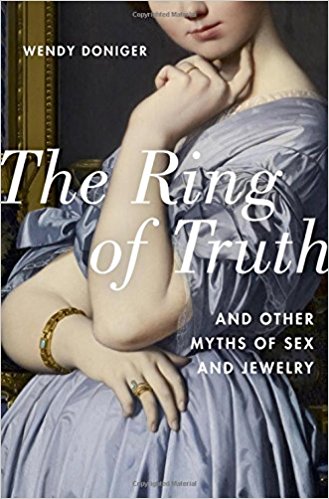What inspired you to write The Ring of Truth: And Other Myths of Sex and Jewelry?
I tend to write books the way people make yogurt: when I finish a book there is often something left over, some new question that begins to germinate in my mind as I wrote the book that I wasn’t able to answer in that book. And that becomes the seed, the driving question for the next book. In this case, I was working on a book about women masquerading as people masquerading as them (The Woman Who Pretended to Be Who She Was, Oxford University Press, 2005), a book that had in turn sprung from the head of another, earlier book of mine about people masquerading as other people in bed (The Bedtrick: Tales of Sex and Masquerade, University of Chicago Press, 2000). My editor noticed that, in many of these stories, jewelry seemed to provide the final clue to the identity of a sexual trickster. And I began to wonder why jewelry was so central to so many stories, why it carried meaning far over and above its beauty or its financial value, particularly sexual meaning.
It seemed to me that since so many people are fascinated by jewelry, they might want to read a book that explored that fascination. Immediately, lots and lots of stories I already knew came to mind, as well as incidents from my own personal history (some of which I used in the preface to the book). And once I started the paper-chase of research, one tale leading me to another, I found so many stories that I hadn’t known before. I also found the dark side of the myth, involving rape and incest and desertion, as well as some very funny and, occasionally, very dirty stories.

The Ring of Truth and Other Myths of Sex and Jewelry
Wendy Doniger
Oxford UP
May 2017
What’s the most important take-home message for readers?
I think most people are unaware, as I was until I started this book, that they share an assumption about women and jewelry, which I would call the slut assumption—the belief that when a woman appears with a new piece of jewelry, she got it by sleeping with some man. And this assumption takes two different forms, which I’ve named after the two film icons who seared my soul when I was a teenager in the 1950s: Doris Day (1924–) and Marilyn Monroe (1926–62). The Doris Day/professional virgin scenario of legitimation (“Get the wedding ring before you go to bed with him”) and the Marilyn Monroe/gold-digger scenario of illegitimation (“Get lots of rings [or bracelets, or necklaces] before [and after] you go to bed with him”). These two paradigms have different historical trajectories, one from the regulation of marriage by religion and the other from the survival strategies of women outside the confines of religion. Together they have exerted a powerful control over the minds of men and women from ancient Greece and India to the contemporary cinema.
The stories about sex and jewelry in my book are myths in the sense of stories believed by many people over a long period, despite persistent evidence that they are not factually true. The point I try to make in my conclusion is that though myths fly in the face of reason, they have power over us because they play into our rationality. Even within the stories, people sometimes exercise reason. For instance, when a man denies that he has slept with a woman and fathered her child, and then she produces a ring that she says he gave her on the night in question and claims it as proof of the child’s paternity, the man may invoke reason by saying, “Sure that’s my ring, but you could have bought it” or “stolen it” or “gotten it from me on some other occasion than in bed” or, indeed, “That’s not my ring.” Yet in the end, the unreasonable argument that the ring proves the paternity is accepted. And outside the story, among audiences over the centuries and across the continents, people keep listening to the tale and retelling versions of it. I think this is because the stories, however unreasonable, have a kind of rationality, in the sense of playing by strict and consistent rules. The conflict then comes down to the tension between what individual intelligence can work out (reason) and what the culture as a whole expects everyone to accept (rationality). The mythic ring confuses the issue, for it is a piece of solid evidence (hence reasonable) but it is invoked to support the claims of irrational romanticism.
The belief that love will last forever, and that your special ring is proof of this, is spectacularly counterfactual and unreasonable but not counterintuitive or irrational. It is entirely intuitive, it is what we want to believe, it is what our deepest intuitions grab hold of instead of reason, and it is what the mythology feeds on.
Is there anything you had to leave out?
I didn’t have to leave out any particular story, but I had to leave out so many great stories! The book would have been even longer than it is. And I keep discovering new wonderful ring stories even now that the book has been published.
What are some of the biggest misconceptions about your topic?
I think the biggest misconception about jewelry is that everyone knows that a girl has to have a diamond engagement ring, that this is a very old custom. Well, no, actually, it is not a very old custom. It is a lie invented by the N. W. Ayer advertising firm hired in 1939 by the de Beers diamond cartel. Riding piggyback on the idea that a man should give a woman a ring if he loves her (which is a very old myth throughout the European world), de Beers just slipped in the word “diamond,” and the motto, A Diamond is Forever, and voila! An instant new myth! And so they bamboozled hundreds of thousands of men into believing that it was—indeed, that it always had been—absolutely essential to spend $10,000 on a diamond engagement ring instead of using the money for a down payment on a condo. This is a great example of the power of myth!
Did you have a specific audience in mind when writing?
I wrote this book for all the women who are fascinated by jewelry, and for some men too. It has a feminist sub-text, showing how men in most cultures have kept women from owning any property but jewelry, and how men told these stories to cast aspersion on that one source of power, to label women as whores and tricksters precisely because they got their jewelry from men. My main hope was that people of both sexes would enjoy the book, but I also hoped that it would make women more thoughtful about letting jewelry—and the men who buy them jewelry—have too much power over them. The younger generation of women nowadays often prefer to buy their own jewelry. . . .
Are you hoping to just inform readers? Entertain them? Piss them off?
Certainly to inform and entertain! Not really to piss off anyone but De Beers!
What alternative title would you give the book?
Are Diamonds Always a Girl’s Best Friend? Myths of Sex and Jewelry
How do you feel about the cover?
I love the cover, the way the designer cropped the Ingres painting to make it more mysterious and suggestive. The Indian edition also has a lovely cover, a painting by Raja Ravi Varma of an Indian woman covered in jewelry and smiling seductively.
Is there a book out there you wish you had written? Which one? Why?
Sure: Anna Karenina. Or The Eustace Diamonds. Or Alice in Wonderland. I always wanted to write a novel, and did write one once, but it was awful (I showed it to some of my friends who are real, published novelists, and they said things like, “I really loved the beginning of Chapter 5 . . . .”) and I never published it.
What’s your next book?
I have a book in press with Yale University Press now, Against Dharma, the Terry Lectures on science and religion that I gave there in 2014, about the ways in which the ancient Indian textbooks of sex (the Kamasutra) and politics (the Arthashastra) subverted religion (dharma). And I’m just now finishing up a memoir of my parents, who came to America from Russia and Vienna early in the 20th century and brought me up in Great Neck, a Jewish suburb on the north shore of Long Island.




